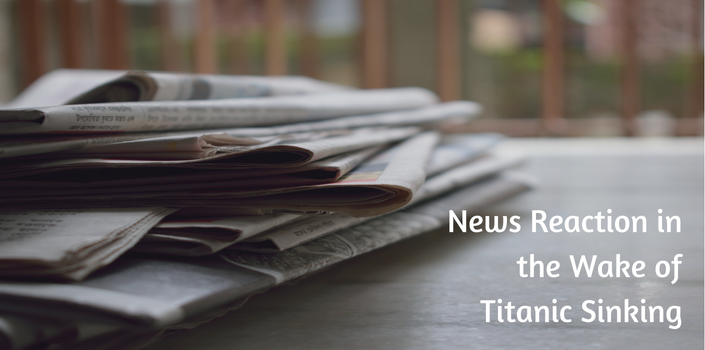October 9, 2013
News Reaction in the Wake of Titanic Sinking – Not so Different Today

Tomorrow marks the hundredth anniversary of the sinking of the Titanic. The Titanic sinking continues to captivate people. The technology used 100 years ago to keep people updated on the news is not so very different from today. News travels much faster now, but uses many of the same tactics.

How News Of The Titanic Sinking Passed
In 1912 ship radios were not able to reach land. Messages that had to reach the shore transmitted from ship to ship. Once a ship close enough to land got the message, it could radio it in. As the Titanic radioed for help several ships turned toward it to rescue people. Others passed the message along to ships closer to land. Finally the message got to a radio station in Newfoundland.
When the news reached New York Times the managing editor, Carr Van Ada, sat with a one paragraph dispatch:
CAPE RACE, Newfoundland, Sunday Night, April 14 (AP) — At 10:25 o’clock tonight the White Star Line steamship Titanic called ‘CQD’ to the Marconi station here, and reported having struck an iceberg. The steamer said that immediate assistance w
as required.
What To Do?
 He then had a decision to make. Keep going with the early edition? Or cancel the early edition and make a big front page story out of the one tiny paragraph? Many newspapers played it safe. They reported the news as nonsense since “no great harm could come to the unsinkable Titanic”. Coverage in London reported, “No Lives Lost”. Van Ada went with his reason and reported the following:
He then had a decision to make. Keep going with the early edition? Or cancel the early edition and make a big front page story out of the one tiny paragraph? Many newspapers played it safe. They reported the news as nonsense since “no great harm could come to the unsinkable Titanic”. Coverage in London reported, “No Lives Lost”. Van Ada went with his reason and reported the following:“New Liner Titanic Hits an Iceberg;
Sinking by the Bow at Midnight;
Women Put Off in Lifeboats;
Last Wireless at 12:27 a.m. Blurred”
Over the next four days, what may be the first 24/7 news cycle began. It parallels today’s news cycle in the wake of a crisis, not only in how people re
acted, but also how rumors began to circulate as fact. As wireless devices were still new, large crowds gathered in places that had the devices to hear the news. Messages traveled from ship to ship to land and then back. The route was never direct. Instead, many message traveled in both directions at once, confusing those tracking them. A message at the same time about a towed ship led many to believe the Titanic was safe and on its way to port.
But How?

Later, as rumors began to die and the facts made known, people wanted to know how the Titanic sunk. The Carpathia, which had picked up the Titanic survivors, radioed back survivor lists. They would not divulge any eyewitness accounts. Why? Because the Times had brokered an exclusive interview with the Titanic’s radio man. As the Carpathia docked the New York police refused to let anyone on board. Marconi, as head of the wireless company, went on board with his manager to secure the radio. The manager turned out to be a Times reporter. The story the next day was an eyewitness account from the Titanic radioman.
Another reporter found himself in the right place at the right time. Carlos Hurd of the St. Louis Dispatch was vacationing aboard the Carpathia. H was able to interview some the survivors before docking in New York City. Hurd was under strict orders not to share any information. Despite this, he threw his copy tied to a buoy into a tugboat hired by his boss Joseph Pulitzer.
 Were a similar event to happen today it is unlikely the death toll would rise as high. Ships are safer, have more lifeboats, and there are strict safety protocols. We also would have had news updates including video at a much faster rate thanks to smartphones. Even so, we see many of the same things when there is a major news story today. Events like 9/11 were rife with rumor even as it was being reported live on the news. The news of Osama Bin Laden’s death broke out quickly but it was days before we knew what actually happened. In conclusion, even after 100 years news traveles faster, but in the same way. There is still some kismet and audacity at play. And peoplestill react by filling in the holes until the facts come to light.
Were a similar event to happen today it is unlikely the death toll would rise as high. Ships are safer, have more lifeboats, and there are strict safety protocols. We also would have had news updates including video at a much faster rate thanks to smartphones. Even so, we see many of the same things when there is a major news story today. Events like 9/11 were rife with rumor even as it was being reported live on the news. The news of Osama Bin Laden’s death broke out quickly but it was days before we knew what actually happened. In conclusion, even after 100 years news traveles faster, but in the same way. There is still some kismet and audacity at play. And peoplestill react by filling in the holes until the facts come to light. 
